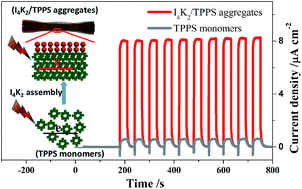Short peptide-regulated aggregation of porphyrins for photoelectric conversion†
Abstract
Photosynthesis in green plants and certain bacteria is an ideal process of solar energy utilization because of its high efficiency and eco-friendliness. Photosynthetic systems usually have sophisticated structures that are constructed through self-assembly of protein, light capturing components and other functional subunits. This inspired researchers to uncover the interaction rules among the photosynthetic subunits and to construct artificial photosynthetic systems via a biomimetic way. Here we selected tetrakis(4-sulfonatophenyl)porphine (TPPS) as a model light-harvesting molecule and short peptide (Ac-I4K2-NH2) self-assembled structures as templates to construct peptide–porphyrin (I4K2/TPPS) co-aggregates via non-covalent interactions. The effects of peptide and porphyrin concentration as well as solution pH on their aggregating behavior and spectroscopic and photoelectric properties were systematically investigated. The results showed that TPPS J-aggregates were obtained under relatively mild conditions in the presence of I4K2 nanostructures and could be easily regulated by the solution pH or molar ratio of TPPS and I4K2. Additionally, great efforts were made to clarify the relationship between the aggregation states of TPPS and their photoelectric properties. The TPPS J-aggregates exhibit a higher photocurrent response compared with other aggregation states as a result of their excellent light capture ability and higher photo-to-electron conversion efficiency. The results provide a promising step towards artificial photosynthetic devices through integrated interaction of organic light capturing components, biomolecules and other functional units.



 Please wait while we load your content...
Please wait while we load your content...